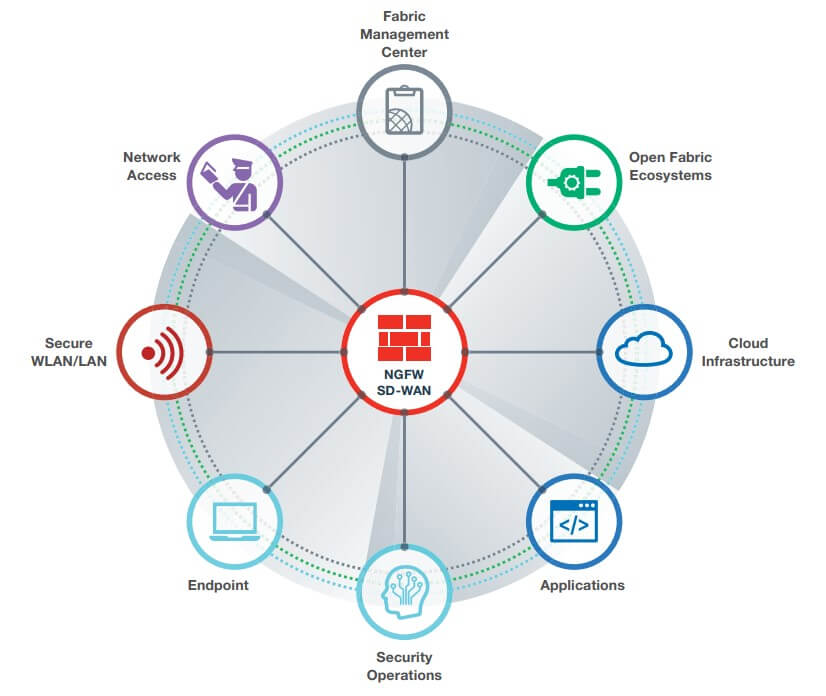The Fortinet Security Fabric: An Overview
Whether you own a Fortinet product or you’re just shopping around, the Fortinet Security Fabric is a term you’re probably seeing a lot of these days. But what is it? Just like actual fabric – many individual fibers weaved together – the Security Fabric is Fortinet’s vast security portfolio intertwined. In short, it’s an integrated solution allowing you to see, manage, and secure your network products in one place. In long? Let’s get into it.
It Starts With the Firewall
Here at Firewalls.com, we often refer to a firewall as the cornerstone of any network setup. The Fortinet Security Fabric treats it that way as well. It’s the hub around which all the spokes of the wheel connect – forgive the mixed metaphors. In this case, with your FortiGate next generation firewall – aka NGFW – you can coordinate the behavior of other Fortinet (and partner) products. That means your FortiGate can run your security show with visibility into all corners of your network. And by the way, it can also function as a Secure SD-WAN powerhouse in case you’ve missed that news. It supports a variety of other security technologies all under the same FortiOS operating system, including:
- Secure Wi-Fi and Switching Access
- Network Access
- The single-console Fabric Management Center
- Open Fabric Ecosystems for partner integrations
- Cloud Infrastructure
- Business-Critical Applications
- Security Operations for automated threat detection, prevention, & response
- Endpoint Protection
What is the goal of the Fortinet secure access solution?
The Fortinet secure access solution as it’s sometimes termed, encompasses secure switching and wireless. The goal is network access that’s easy to manage for admins while at the same time high performing for users.
Access is a word that pops up a few times in this conversation – as both creating and controlling it is key for an optimized, secure network. The Security Fabric integrates with FortiAPs to provide and manage secure wireless access and FortiSwitches to do what switches do – essentially create a network. And speaking of access, with the Fortinet Security Fabric, you can implement a zero-trust network access policy throughout your network.
It starts with network access detection, continuous monitoring, and control. Next, you can implement multi-factor authentication with a solution like FortiToken. Finally, ongoing visibility and access control of all your endpoints is a must – something you can accomplish with FortiClient. When implemented together, you’ll make it extremely difficult for hackers to gain access to your network – keeping your important data secure.


How does the Security Fabric secure my network?
The Security Fabric is designed with network security as a priority. Fortinet refers to this as security driven networking. This begins with the FortiGate firewall as the front-line network protector. But it also includes the secure access solutions of the switch and wireless appliances, and dynamic cloud security to secure your cloud presence.
We’ve already discussed some of the role the FortiGate plays in the Security Fabric, but let’s expand a bit more. We already know the FortiGate is a firewall. But it also includes other critical security measures. These include a secure web gateway to help stop phishing attacks, SSL/TLS decryption to catch encrypted threats without slowing performance, and intent-based segmentation. And we can’t forget about the Secure SD-WAN component which extends this security outside the physical boundaries of the office to branch locations.
As for the cloud, the Security Fabric integrates a wide array of cloud-based security solutions. We know everyone has some type of cloud presence, so staying protected in that space is paramount. In addition to the FortiGate firewall, Fortinet offers FortiWeb web application firewalls. Email is also a major player in the cloud, and we know that email is a main entry point for malware. The good news is FortiMail is built to stop both traditional and advanced email threats.
Another note on all this security talk. The Fortinet Fabric Manager is your single console to manage all of the solutions mentioned above – and more. But the beauty is you won’t have to micromanage your security. Fortinet’s solutions heavily leverage artificial intelligence and automated security. FortiGuard AI incorporates real-time threat data gathered by FortiGuard Labs to ID and stop just about any online hazard you can think of. In essence, Fortinet Security Fabric solutions are constantly working behind the scenes to stop threats.
Who are Fortinet Security Fabric partners?
The list of Fortinet Security Fabric open fabric ecosystem partners is too numerous to include here. But these partners include heavyweights like Amazon Web Services, Google Cloud, Intel, Oracle, and Siemens to name just a few. The partners leverage the Security Fabric to offer end-to-end security solutions in partnership with Fortinet. It’s just one more way your network gets comprehensive coverage.
How do I get started with the Security Fabric?
We’ve touched on a number of aspects of the Security Fabric in this piece. But in the end, as in the beginning, it all comes back to the firewall. To get started on your Security Fabric journey, find the FortiGate firewall that’s right for your network.





